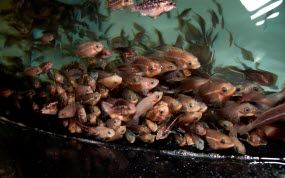
|
|
Breeding wrasse in captivity is a complex technological operation, and for it to succeed, new methods of care and feeding must be developed. Photo: Thor Nielsen. |
A few years ago, fish farms in Chile produced enormous numbers of salmon. Now the industry is on its knees as a result of several years of disease and devastation by lice.
Also in Norway, salmon lice and diseases are spreading. Large net pens containing large numbers of fish make it difficult to manage treatment and the parasite’s resistance to counter-measures is increasing.
Both environmentalists and researchers believe that the industry has expanded too rapidly and that this threatens the wild salmon – and the industry itself. In the worst case, the situation here could result in widespread slaughter or the total collapse of salmon farming.
Team Salmon Louse
There is a frenzy of activity in the meeting rooms at SINTEF SeaLab. Research Manager Leif Magne Sunde has just welcomed participants to a workshop. In all, twelve specialists with various backgrounds in SINTEF are sharing their experience and technical expertise in order to hatch
new ideas in the battle against the salmon louse. The project has been given the name “Team Salmon Louse".
One of the methods being discussed is the use of a small fish, the wrasse. The salmon louse is high on the wrasse’s list of favourite foods: it picks the lice right off the salmon. Demand for the wrasse is so high that researchers fear that fishing will eradicate the species from coastal waters. As a result, work is now in progress to establish farming of wrasse.
Wrasse farming
At Marine Harvest’s site near Bergen, SINTEF is assisting marine biologist Espen Grøtan in operating the world’s first fish farm for wrasse. Breeding this species in captivity is a complex technological operation, and for it to succeed, new methods of care and feeding must be developed.
In eight large tanks each containing nine thousand litres of water, the fifty-centimetre-long brood stock fish swim among artificial seaweed created from shredded tarpaulins.
The fish are beautiful, in shades of brown, blue, red and orange, and almost resemble something you might find in a tropical aquarium. They say that no two wrasse have the same pattern. At the bottom of the tank lie the remains of their lunch: prawns of restaurant quality.
The parents of what are to become the natural cure for salmon lice are just as discriminating as their offspring. In spite of the serious challenges, Marine Harvest, a major aquaculture operator, believes that the investment will be successful.
“The wrasse is a fastidious creature, both as a child and as an adult. Many factors are involved in getting the two to three-millimetre long larvae to feed and to grow rapidly. Correct feeding after hatching is one of the most important requirements,” Gunvor Øie, a SINTEF researcher, explains.
Only the right surroundings and warm baths are good enough
The fish needs high water temperatures during hatching. As it grows, it needs cooler water and access to concealment. Keeping the necessary cover clean in a breeding tank is important and can be resource-demanding.
Another problem is the risk of infection in the hatching phase: Under natural conditions, the wrasse builds small nests for its eggs on the seabed. In the laboratory, mats of artificial weed are used, in which the eggs thrive, but so do bacteria.
“When the eggs have hatched, bacteria growth must be kept under control. We still don’t know the best way to do this without damaging the eggs and fry,” says Gunvor Øie.
At the same time, tiny crustaceans are being studied as potential “baby food”. The researchers hope that if the initial feeding is optimal, the fish will grow more rapidly in their first year of life. Their diet consists of tiny zooplankton called rotifers. Because several types of rotifers (commonly known as wheel animals) exist, a laborious, systematic hunt is in progress for the best alternative. Researcher Gunvor Øien is convinced that the young wrasse will survive if she can find rotifers of the right quality.
If she is right and the studies are successful, the biological cure for salmon lice will be welcomed by the aquaculture industry, the authorities and the environmentalists – not to mention the salmon themselves.
Key facts about the salmon louse:
Latin name: Lepeophtheirus salmonis
Habitat: Naturally occurring in Norwegian marine waters. Numbers have increased significantly with the growth of the aquaculture industry.
Size: 8–12 mm (adult female including egg strings) The male is half as long.
Diet: The skin and blood of salmon. The louse does not feed until it has attached itself to a host fish.
Reproduction: Year-round, but reproduces more rapidly and produces greater numbers when the water temperature rises during the spring.
Distribution: By means of water currents in the fjords and coastal areas.
Counter-measures: Biological methods (wrasse) or chemicals (medication).
SINTEF has set up a multidisciplinary team to develop methods of combating the salmon louse. The team is developing biological (using wrasse), chemical and technological methods, as well as carrying out modelling and monitoring of the migration pattern and life-cycle of the louse. The team is working in close co-operation with the aquaculture industry, other research institutions, the government, industry in general and inventors. For more information, go to: www.sintef.no/lakselus
Source: The Norwegian Institute of Marine Research and SINTEF
